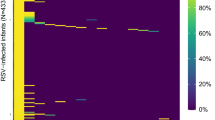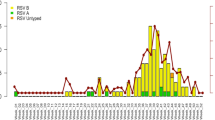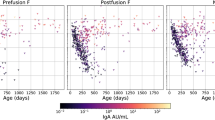Abstract
Heterogeneity in respiratory syncytial virus (RSV) disease severity likely is due to a combination of host and viral factors. Infection with RSV subgroup A is thought to produce more severe disease than RSV-B. Higher RSV loads correlate with greater disease severity in hospitalized infants. Whether subgroup-specific variations in disease severity result from differences in RSV load has not been studied. A total of 102 RSV-hospitalized infants <2 y of age were studied. Nasal washes were collected in a standardized manner and were cultured in <3 h in parallel with an RSV quantitative standard in a HEp-2 plaque assay. RSV-A (72%) was more frequent than RSV-B. Disease severity risk factors were similar between subgroups. RSV loads were similar between A and B subgroups (4.77 versus 4.68 log PFU/mL). Measures of disease severity were also similar between subgroups.
Similar content being viewed by others
Log in or create a free account to read this content
Gain free access to this article, as well as selected content from this journal and more on nature.com
or
Abbreviations
- RSV:
-
respiratory syncytial virus
References
Glezen P, Denny FW 1973 Epidemiology of acute lower respiratory disease in children. N Engl J Med 288: 498–505
Glezen WP, Taber LH, Frank AL, Kasel JA 1986 Risk of primary infection and reinfection with respiratory syncytial virus. Am J Dis Child 140: 543–546
Boyce TG, Mellen BG, Mitchel EF Jr, Wright PF, Griffin MR 2000 Rates of hospitalization for respiratory syncytial virus infection among children in medicaid. J Pediatr 137: 865–870
Wang EE, Law BJ, Stephens D 1995 Pediatric Investigators Collaborative Network on Infections in Canada (PICNIC) prospective study of risk factors and outcomes in patients hospitalized with respiratory syncytial viral lower respiratory tract infection. J Pediatr 126: 212–219
Buckingham SC, Quasney MW, Bush AJ, DeVincenzo JP 2001 Respiratory syncytial virus infections in the pediatric intensive care unit: clinical characteristics and risk factors for adverse outcomes. Pediatr Crit Care Med 2: 318–323
Wang EE, Law BJ, Robinson JL, Dobson S, al Jumaah S, Stephens D, Boucher FD, McDonald J, Mitchell I, MacDonald NE 1997 PICNIC (Pediatric Investigators Collaborative Network on Infections in Canada) study of the role of age and respiratory syncytial virus neutralizing antibody on respiratory syncytial virus illness in patients with underlying heart or lung disease. Pediatrics 99( 3). Available at: www.pediatrics.org/cgi/content/full/99/3/e9
Brouard J, Freymuth F, Constantini S, Petitjean J, de Schrevel G, Duhamel JF 1993 [Prevalence and clinical aspects of A and B subgroups of respiratory syncytial virus infection. Observation of 8 consecutive epidemics between 1982 and 1990]. Arch Fr Pediatr 50: 639–643
Brandenburg AH, van Beek R, Moll HA, Osterhaus AD, Claas EC 2000 G protein variation in respiratory syncytial virus group A does not correlate with clinical severity. J Clin Microbiol 38: 3849–3852
Hall CB, Walsh EE, Schnabel KC, Long CE, McConnochie KM, Hildreth SW, Anderson LJ 1990 Occurrence of groups A and B of respiratory syncytial virus over 15 years: associated epidemiologic and clinical characteristics in hospitalized and ambulatory children. J Infect Dis 162: 1283–1290
McConnochie KM, Hall CB, Walsh EE, Roghmann KJ 1990 Variation in severity of respiratory syncytial virus infections with subtype. J Pediatr 117: 52–62
Mufson MA, Akerlind-Stopner B, Orvell C, Belshe RB, Norrby E 1991 A single-season epidemic with respiratory syncytial virus subgroup B2 during 10 epidemic years, 1978 to 1988. J Clin Microbiol 29: 162–165
Walsh EE, McConnochie KM, Long CE, Hall CB 1997 Severity of respiratory syncytial virus infection is related to virus strain. J Infect Dis 175: 814–820
Malley R, DeVincenzo J, Ramilo O, Dennehy PH, Meissner HC, Gruber WC, Sanchez PJ, Jafri H, Balsley J, Carlin D, Buckingham S, Vernacchio L, Ambrosino DM 1998 Reduction of respiratory syncytial virus (RSV) in tracheal aspirates in intubated infants using humanized monoclonal antibody to RSV F protein. J Infect Dis 178: 1555–1561
Buckingham SC, Bush AJ, DeVincenzo JP 2000 Nasal quantity of respiratory syncytial virus correlates with disease severity in hospitalized infants. Pediatr Infect Dis J 19: 113–117
Wright PF, Gruber WC, Peters M, Reed G, Zhu Y, Robinson F, Coleman-Dockery S, Graham BS 2002 Illness severity, viral shedding, and antibody responses in infants hospitalized with bronchiolitis caused by respiratory syncytial virus. J Infect Dis 185: 1011–1018
DeVincenzo JP, Buckingham SC 2002 Relationship between respiratory syncytial virus load and illness severity in children. comment J Infect Dis 186: 1376–1377; author reply 1377
DeVincenzo J, Bush A, Harrison L, Buckingham S, Murphy J, Prinz A, Young L 2001 Influence of host and viral factors in respiratory syncytial virus (RSV) duration of hospitalization. [abstract 1352]. Pediatr Res 49: 237A
DeVincenzo JP, Bush AJ, Aitken J, Harrison L 2003 Respiratory syncytial virus (RSV) load correlates with disease severity: Results of a prospective study of previously healthy naturally infected infants. Presented at the 43rd Annual Interscience Conference on Antimicrobial Agents and Chemotherapy (ICAAC), Chicago, IL, September 14–17 2003
Malley R, Vernacchio L, Devincenzo J, Ramilo O, Dennehy PH, Meissner HC, Gruber WC, Jafri HS, Sanchez PJ, Macdonald K, Montana JB, Thompson CM, Ambrosino DM 2000 Enzyme-linked immunosorbent assay to assess respiratory syncytial virus concentration and correlate results with inflammatory mediators in tracheal secretions. Pediatr Infect Dis J 19: 1–7
Martinello RA, Chen MD, Weibel C, Kahn JS 2002 Correlation between respiratory syncytial virus genotype and severity of illness. J Infect Dis 186: 839–842
Fletcher JN, Smyth RL, Thomas HM, Ashby D, Hart CA 1997 Respiratory syncytial virus genotypes and disease severity among children in hospital. Arch Dis Child 77: 508–511
Acknowledgements
The author thanks Drs. Elaine Tuomanen and Malak Kotb for guidance and is grateful for the indispensable assistance of Lisa Harrison and Jody Aitken in collection of the data presented. The author also appreciates the assistance of the staff of the Le Bonheur Virology Lab and the physicians, the parents, and the infants who participated in this study.
Author information
Authors and Affiliations
Additional information
This research was funded in part by the following grants awarded to J.D.: National Institutes of Health RR16187, Children's Foundation Research Center, and the General Clinical Research Center UHPHS RR00211.
This information was presented in part as Abstract 658 at the 41st Interscience Conference on Antimicrobial Agents and Chemotherapy; Chicago, IL; December 2001.
Rights and permissions
About this article
Cite this article
Devincenzo, J. Natural Infection of Infants with Respiratory Syncytial Virus Subgroups A and B: A Study of Frequency, Disease Severity, and Viral Load. Pediatr Res 56, 914–917 (2004). https://doi.org/10.1203/01.PDR.0000145255.86117.6A
Received:
Accepted:
Issue date:
DOI: https://doi.org/10.1203/01.PDR.0000145255.86117.6A
This article is cited by
-
Persistence and continuous evolution of the human respiratory syncytial virus in northern Taiwan for two decades
Scientific Reports (2019)
-
Structural basis of respiratory syncytial virus subtype-dependent neutralization by an antibody targeting the fusion glycoprotein
Nature Communications (2017)
-
A Virological and Phylogenetic Analysis of the Emergence of New Clades of Respiratory Syncytial Virus
Scientific Reports (2017)
-
Therapeutic efficacy of a respiratory syncytial virus fusion inhibitor
Nature Communications (2017)
-
Association of RSV-A ON1 genotype with Increased Pediatric Acute Lower Respiratory Tract Infection in Vietnam
Scientific Reports (2016)



